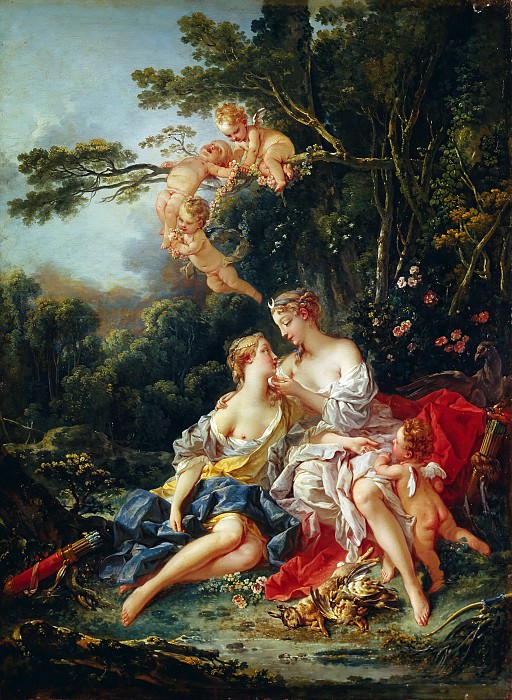Jupiter And Callisto Francois Boucher (1703-1770)
Francois Boucher – Jupiter And Callisto
Edit attribution
Download full size: 2375×3248 px (2,1 Mb)
Painter: Francois Boucher
In early eighteenth-century France, the most popular style in art was rococo. The rococo was characterized by a depiction of luxury, surfeit, an abundance of decorative elements, and whimsical forms. Paintings in that period served mainly as interior decoration. Characters were depicted like porcelain figurines; at the same time, the bodies in the paintings were typical of lush, sensual forms. The subjects of the paintings are most often pastoral.
Description of the painting "Jupiter and Callisto" by François Boucher
In early eighteenth-century France, the most popular style in art was rococo. The rococo was characterized by a depiction of luxury, surfeit, an abundance of decorative elements, and whimsical forms. Paintings in that period served mainly as interior decoration. Characters were depicted like porcelain figurines; at the same time, the bodies in the paintings were typical of lush, sensual forms. The subjects of the paintings are most often pastoral. Picturesque lawns bordered by trees and bushes are most often used as backgrounds; a river or stream is also an obligatory element of the landscape.
François Boucher was the most striking artist of the Rococo era. In addition to painting, he made sketches for porcelain paintings and tapestries, was fond of sculpture, created prints, painted interiors. All his works are characterized by light pink, blue and soft green tones.
The plot of the picture is taken from an ancient Roman myth. According to legend, the god Jupiter has grown passionate about the nymph Callisto, and not to scare her, appeared before the desired girl in the guise of the goddess Diana. In the female form the god tried to seduce Callisto. The nymph, as Diana’s companion, had accompanied her on the hunt, so she was not surprised to see her mistress. Thus Jupiter succeeded in seducing her lover, who had taken a vow of virginity. To French society the myth was widely known thanks to Ovid’s Metamorphoses.
Boucher depicted two flirtatious girls against a pastoral landscape; the group of cupids performs a decorative task, outwardly resembling a wreath or a garland of flowers. There is nothing divine or majestic about the young heroines; most likely, the artist quite accurately conveyed the appearance of the French sitters who posed for the work. It is generally accepted that the beauty of such paintings can only be appreciated in the appropriate interiors, of which they were a part.
Кому понравилось
Пожалуйста, подождите
На эту операцию может потребоваться несколько секунд.
Информация появится в новом окне,
если открытие новых окон не запрещено в настройках вашего браузера.
You need to login
Для работы с коллекциями – пожалуйста, войдите в аккаунт (open in new window).




















You cannot comment Why?
This painting, Jupiter and Callisto by François Boucher, depicts a scene of intimacy and desire within a lush, Arcadian landscape. The central figures are two nude or semi-nude women, one of whom is looking tenderly at the other, gently touching her face. These figures are believed to represent Jupiter and Callisto, though the interpretation of their dynamic is open to debate, as Jupiter is traditionally depicted as male.
Several subtexts enrich the meaning of the painting:
Mythological Allusion: The title directly refers to a Greek myth where Jupiter, disguised as Diana, seduces the nymph Callisto. This narrative layer introduces themes of deception, desire, and transformation, as Callisto is later turned into a bear by Juno and eventually placed among the stars as Ursa Major. However, Bouchers depiction emphasizes the sensuality and tenderness of the moment rather than the act of deception.
Erotic Sensuality: Boucher is renowned for his Rococo style, characterized by light, playful, and often sensual depictions of mythological and allegorical subjects. The soft, luminous skin of the figures, their relaxed poses, and the intimate gesture between them all contribute to an overwhelmingly erotic atmosphere. Flowers, often symbols of love and fertility, are also present, further enhancing this sensuality.
Allegory of Love and Beauty: The scene can be interpreted as an allegory for the power of love and beauty. The presence of cherubic figures (putti) scattered in the upper branches, often associated with love and fertility, reinforces this theme. They are shown interacting with flowers, suggesting the blossoming and playful nature of love.
Symbolism of Attributes: The quiver of arrows and a bow lying on the ground to the left are traditional attributes of Diana, the goddess of the hunt and chastity. Their presence might allude to Callistos former status as a follower of Diana, or perhaps symbolize cupids arrows, hinting at the powerful influence of love. The dead birds in the foreground could symbolize relinquished innocence or the spoils of love.
Nature as a Setting for Intimacy: The verdant, almost dreamlike setting of trees, foliage, and water underscores the naturalness and perhaps the primal force of the emotions being depicted. The landscape is not merely a backdrop but an active participant in creating an atmosphere conducive to intimacy and pleasure.